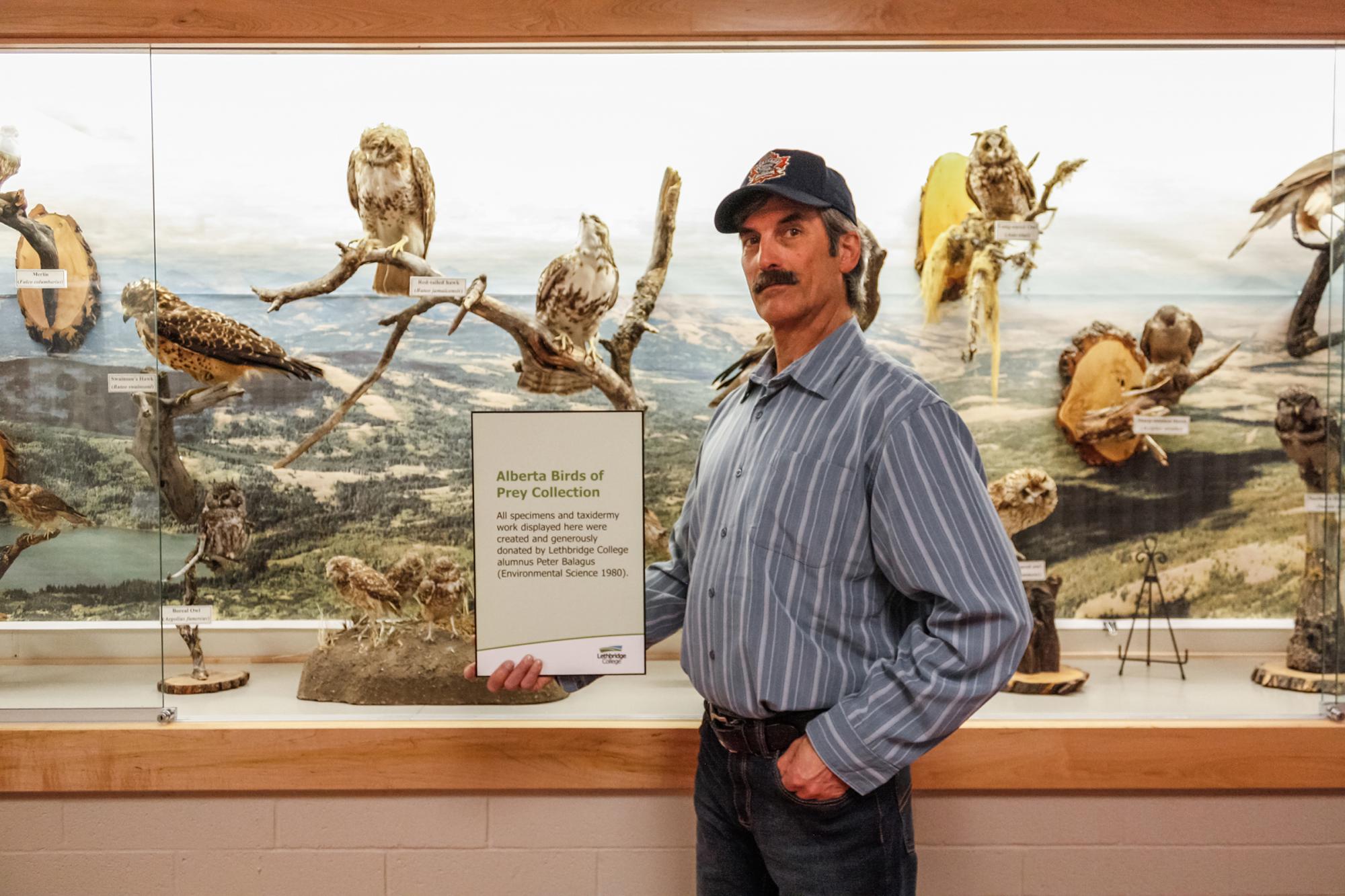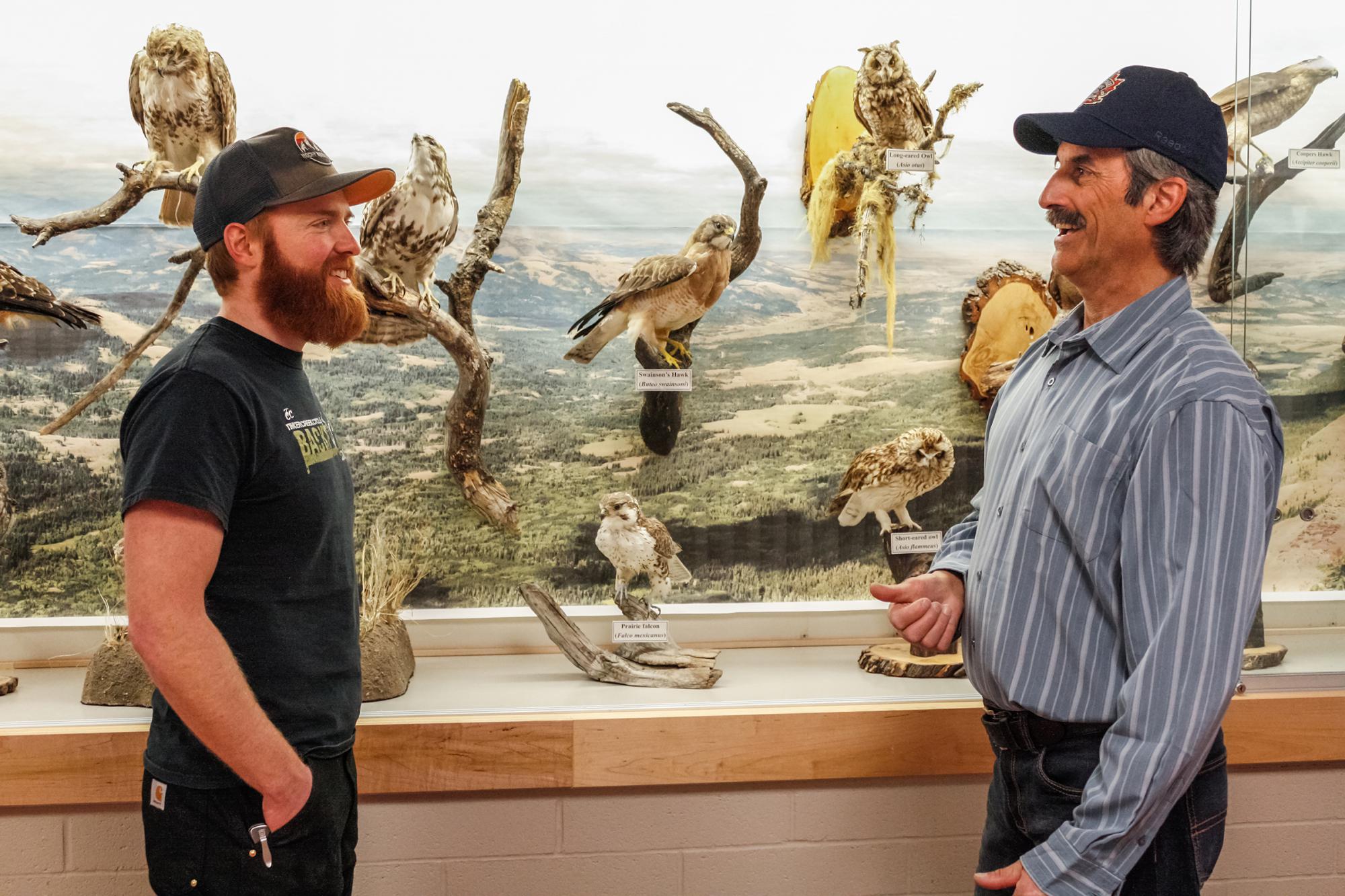A bird in the hand is worth two in a book
An appraiser pegged the value of a collection of mounted raptors at about $18,000, but if you ask David Haight, this donation to Lethbridge College is priceless.
Haight, coordinator of the labs in the Cousins Science Centre, says the 24 birds of prey displayed on the second floor of the building, represent just a fraction of alumni Peter Balagus’s gift.
Balagus (Environmental Science, 1979) also gave a cabinet full of about 200 other specimens including small mammal skins, skulls and skeletons, and bird skins and wings; each carefully catalogued and preserved. They are not on public display but students can access them for study.
Such access allows students to see for themselves the subtle differences between species and genders of the same species.
“When I was a student, I thought ducks are ducks are ducks, but they’re not,” says Haight (Environmental Science 2006).
Balagus recently visited the college with his wife Colleen, who was making her first visit to campus. They emerged from the Cousins Building stairwell to be greeted by the raptor display, set against a panoramic photo taken from Table Mountain. The photographer was college lab technician Jonny Friesen, who organized the display.
“The background is beyond what I anticipated,” Balagus says. “It’s absolutely fabulous. It’s humbling and moving.”
Birds of prey display pays attention to habitat and habits
The hobby taxidermist of over 40-plus years admits to initially feeling some regret about giving away the birds he found and preserved.

“I was second guessing myself until I saw their new home. Then I felt a comfort zone and satisfaction that the decision was best and right.”
The birds were found dead in Balagus’s travels as a wildlife biologist and environmental consultant. One, in particular, was something of a travel companion when he was working in the Caroline, Alta., area.
Balagus points to the great grey owl that dominates the left side of the display.
“I saw it every day, sitting on a fence post, at the side of the road,” he says. “One day it wasn’t sitting there.”
Balagus stopped his vehicle and found the owl had been struck and killed. He mounted the bird on a barbed wire fence post, just the way he remembers it.
You’ll see that attention to detail in all the mounts. They are posed as they would be seen in nature. The long-eared owl, a boreal forest dweller, is perched on a tamarack branch covered in lichen. Others are seen clutching their natural prey.
Keeping the mounts true to the birds’ nature is “out of respect for them and their unfortunate death,” he says.
Haight says the details enhance the learning experience as does the diversity of the collection.
Donor credits college for giving him practical skills for his career
“To find that variety, it’s a lifetime of work,” Haight says. “You can see the feathers up close and see the differences in their shape and colour. You can look at the beak pattern, the feather patterns. It makes a difference.”
Balagus, 61, took up taxidermy as a hobby at 17. He attended the University of Manitoba for three years and was encouraged to enrol in Lethbridge College’s Environmental Science program by a colleague in Manitoba, where Balagus was raised.
After getting his college diploma, he returned to U of M to complete his degree, with a major in zoology and minor in ecology. His career has been spent in the public and private sectors, and most recently, as an independent consultant conducting systematic wildlife surveys for developers to ensure they mitigate any damage to habitat including wetlands.
“I always wanted to work with critters,” he says. While the university gave him theoretical knowledge, “the college taught me what I needed to know for my career.”
Over the years, he used his collection to teach others. Through his gift to the college, he passes along a legacy of hands-on knowledge.
“It’s a bird in the hand,” Balagus says. “I like to think the collectibles will add to these students’ aspirations.”
Beyond fueling their career goals, he hopes students will adopt a sense of wonder and intrigue at nature.
“It’s the CSI thing. That still intrigues me. A scenario happened here. Maybe there’s blood and hair in the snow, and tracks. What is this? What happened here?”
Haight says the Balagus donation enhances the college’s already enviable collection of wildlife.
Balagus continues to mount birds the college receives from other sources. His most recent work is of three burrowing owls in a diorama setting. The owls are species at risk in Alberta, possession of which is tightly controlled by the province.
He hasn’t stopped looking for artifacts.
“I’m still hoping to find a snowy owl, but for the bird’s sake, I’m not wishing it happens” he says.
